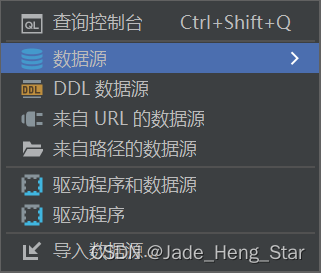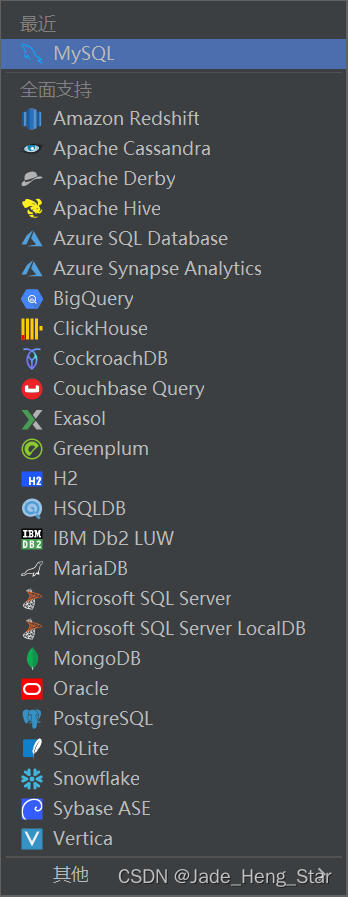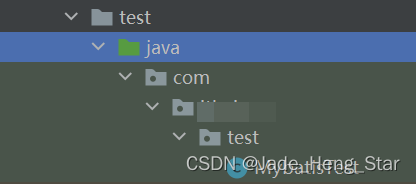【MyBatis 基础】
一、MyBatis 简介及快速入门
- MyBatis 是一款优秀的持久层框架,用于简化 JDBC 开发
- MyBatis 本是 Apache 的一个开源项目 iBatis ,2010年这个项目由 Apache Software Foundation 迁移到了 Google Code,并且改名为 MyBatis ,2013年11月迁移到 GitHub
- 官网:MyBatis 官网网址
-
持久层:
- 负责将数据保存到数据库的那一层代码
- JavaEE 三层架构:表现层、业务层、持久层
-
框架:
- 框架就是一个半成品的软件,是一套可重用的、通用的、软件基础代码模型
- 在框架的基础之上构建软件编写更加高效、规范、通用、可扩展
1. MyBatis 简化 JDBC
JDBC 缺点:
- 硬编码
- 注册驱动,获取连接
- SQL 语句
- 操作繁琐
- 手动设置参数
- 手动封装结果集
MyBatis 简化:
- 将硬编码写入配置文件
- 将操作繁琐的步骤自动完成
MyBatis 免除了几乎所有的 JDBC 代码以及设置参数和获取结果集的工作
2. MyBatis 的快速入门
(1)查询 user 表中所有数据
- 创建 user 表,添加数据
- 创建模块,导入坐标
- 编写 MyBatis 核心配置文件 → 替换连接信息,解决硬编码问题
- 编写 SQL 映射文件 → 统一管理 SQL 语句,解决硬编码问题
- 编码
- 定义 POJO 类
- 加载核心配置文件,获取 SqlSessionFactory 对象
- 获取 SqlSession 对象,执行 SQL 语句
- 释放资源
① 创建 user 表,添加数据
drop table if exists user;
create table user(
id int primary key auto_increment,
username varchar(20),
password varchar(20),
gender char(1),
addr varchar(30)
);
insert into user values (1,'张三','123','男','北京');
insert into user values (2,'李四','234','女','天津');
insert into user values (3,'王五','345','男','西安');
② 创建模块,导入坐标
<dependencies>
<!-- 添加 mybatis 依赖 -->
<dependency>
<groupId>org.mybatis</groupId>
<artifactId>mybatis</artifactId>
<version>3.5.5</version>
</dependency>
<!-- 添加 mysql 依赖 -->
<dependency>
<groupId>mysql</groupId>
<artifactId>mysql-connector-java</artifactId>
<version>5.1.46</version>
</dependency>
<!-- 添加 junit 依赖 -->
<dependency>
<groupId>junit</groupId>
<artifactId>junit</artifactId>
<version>4.13</version>
<scope>test</scope>
</dependency>
<!-- 添加 logback-classic 依赖 -->
<dependency>
<groupId>ch.qos.logback</groupId>
<artifactId>logback-classic</artifactId>
<version>1.2.3</version>
</dependency>
<!-- 添加 logback-core 依赖 -->
<dependency>
<groupId>ch.qos.logback</groupId>
<artifactId>logback-core</artifactId>
<version>1.2.3</version>
</dependency>
</dependencies>
并且需要一个配置文件:
<?xml version="1.0" encoding="UTF-8"?>
<configuration>
<!--
CONSOLE :表示当前的日志信息是可以输出到控制台的。
-->
<appender name="Console" class="ch.qos.logback.core.ConsoleAppender">
<encoder>
<pattern>[%level] %blue(%d{HH:mm:ss.SSS}) %cyan([%thread]) %boldGreen(%logger{15}) - %msg %n</pattern>
</encoder>
</appender>
<logger name="com.xxxxxxx" level="DEBUG" additivity="false">
<appender-ref ref="Console"/>
</logger>
<!--
level:用来设置打印级别,大小写无关:TRACE, DEBUG, INFO, WARN, ERROR, ALL 和 OFF
, 默认debug
<root>可以包含零个或多个<appender-ref>元素,标识这个输出位置将会被本日志级别控制。
-->
<root level="DEBUG">
<appender-ref ref="Console"/>
</root>
</configuration>
③ 编写 MyBatis 核心配置文件
MyBatis 官网中给出了入门案例,可根据示例进行操作
Ⅰ、 官网操作
以下出自官网:
- 创建文件并将配置文件命名为:
xxx.xml文件即可(例如:mybatis-config.xml) - XML 配置文件中包含了对 MyBatis 系统的核心设置,包括获取数据库连接实例的数据源(DataSource)以及决定事务作用域和控制方式的事务管理器(TransactionManager)。后面会再探讨 XML 配置文件的详细内容,这里先给出一个简单的示例:
<?xml version="1.0" encoding="UTF-8" ?>
<!DOCTYPE configuration
PUBLIC "-//mybatis.org//DTD Config 3.0//EN"
"http://mybatis.org/dtd/mybatis-3-config.dtd">
<configuration>
<environments default="development">
<environment id="development">
<transactionManager type="JDBC"/>
<dataSource type="POOLED">
<property name="driver" value="${driver}"/>
<property name="url" value="${url}"/>
<property name="username" value="${username}"/>
<property name="password" value="${password}"/>
</dataSource>
</environment>
</environments>
<mappers>
<mapper resource="org/mybatis/example/BlogMapper.xml"/>
</mappers>
</configuration>
Ⅱ、 根据需求更改
个人对配置文件进行更改:
<?xml version="1.0" encoding="UTF-8" ?>
<!DOCTYPE configuration
PUBLIC "-//mybatis.org//DTD Config 3.0//EN"
"http://mybatis.org/dtd/mybatis-3-config.dtd">
<configuration>
<environments default="development">
<environment id="development">
<transactionManager type="JDBC"/>
<dataSource type="POOLED">
<!-- 数据库连接信息 -->
<property name="driver" value="com.mysql.jdbc.Driver"/>
<property name="url" value="jdbc:mysql:///mybatis?useSSL=false"/>
<property name="username" value="root"/>
<property name="password" value="root"/>
</dataSource>
</environment>
</environments>
<mappers>
<mapper resource="UserMapper.xml"/>
</mappers>
</configuration>
④ 编写 SQL 映射文件
Ⅰ、 官网操作
- 创建 SQL 映射文件:
<?xml version="1.0" encoding="UTF-8" ?>
<!DOCTYPE mapper
PUBLIC "-//mybatis.org//DTD Mapper 3.0//EN"
"http://mybatis.org/dtd/mybatis-3-mapper.dtd">
<mapper namespace="org.mybatis.example.BlogMapper">
<select id="selectBlog" resultType="Blog">
select * from Blog where id = #{id}
</select>
</mapper>
- 映射文件的命名一般遵循驼峰命名并且:操作哪个表并且加上 Mapper 和后缀即可(例如:
UserMapper.xml)
Ⅱ、 根据需求更改
- 首先需要在以下示例的地方创建 User 实体类

- 对 SQL 映射文件进行进一步修改
<?xml version="1.0" encoding="UTF-8" ?>
<!DOCTYPE mapper
PUBLIC "-//mybatis.org//DTD Mapper 3.0//EN"
"http://mybatis.org/dtd/mybatis-3-mapper.dtd">
<!--
namespace:名称空间,必须进行重命名并且不可以不写
-->
<mapper namespace="test">
<select id="selectAll" resultType="com.xxxxxxx.pojo.User">
/* 这里的 id 是这条语句唯一标识,resultType 是操作对应的 User 类型*/
select * from user ;
</select>
</mapper>
⑤ 编码
- 创建的 User 类
public class User {
private Integer id;
private String username;
private String password;
private String gender;
private String addr;
@Override
public String toString() {
return "User{" +
"id=" + id +
", username='" + username + '\'' +
", password='" + password + '\'' +
", gender='" + gender + '\'' +
", addr='" + addr + '\'' +
'}';
}
public Integer getId() {
return id;
}
public void setId(Integer id) {
this.id = id;
}
public String getUsername() {
return username;
}
public void setUsername(String username) {
this.username = username;
}
public String getPassword() {
return password;
}
public void setPassword(String password) {
this.password = password;
}
public String getGender() {
return gender;
}
public void setGender(String gender) {
this.gender = gender;
}
public String getAddr() {
return addr;
}
public void setAddr(String addr) {
this.addr = addr;
}
}
- 在 com.xxxxxxx 下创建测试类
Ⅰ、 官网操作
String resource = "org/mybatis/example/mybatis-config.xml";
InputStream inputStream = Resources.getResourceAsStream(resource);
SqlSessionFactory sqlSessionFactory = new SqlSessionFactoryBuilder().build(inputStream);
Ⅱ、 根据需求更改
// 1. 加载 mybatis 的核心配置文件,获取 SqlSessionFactory
String resource = "mybatis-config.xml";
InputStream inputStream = Resources.getResourceAsStream(resource);
SqlSessionFactory sqlSessionFactory = new SqlSessionFactoryBuilder().build(inputStream);
测试类:
public class MybatisDemo {
public static void main(String[] args) throws IOException {
// 1. 加载 mybatis 的核心配置文件,获取 SqlSessionFactory
String resource = "mybatis-config.xml";
InputStream inputStream = Resources.getResourceAsStream(resource);
SqlSessionFactory sqlSessionFactory = new SqlSessionFactoryBuilder().build(inputStream);
// 2. 获取 SqlSession 对象,用它来执行 SQL 语句
SqlSession sqlSession = sqlSessionFactory.openSession();
// 3. 执行 SQL 语句
List<User> users = sqlSession.selectList("test.selectAll");
System.out.println(users);
// 4. 释放资源
sqlSession.close();
}
}
3. 解决 SQL 映射文件的警告提示
- 产生原因: IDEA 和数据库没有建立连接,不识别表信息
- 解决方式:在 IDEA 中配置 MySQL 数据库连接


二、 Mapper 代理开发
- 解决原生方式中的硬编码
- 简化后执行 SQL 语句


1. 使用 Mapper 代理方式完成入门案例
步骤:需要满足前三条规则,再进行编码开发
- 定义与 SQL 映射文件同名的 Mapper 接口,并且将 Mapper 接口和 SQL 映射文件放置在同一目录下
- 设置 SQL 映射文件的 username 属性为 Mapper 接口的全限定名
- 在 Mapper 接口中定义方法,方法名就是 SQL 映射文件中的 SQL 语句的 id,并保持参数类型和返回值类型一致
- 编码
- 通过 SqlSession 的 getMapper 方法获取 Mapper 接口的代理对象
- 调用对应方法完成 SQL 语句的执行
细节:如果 Mapper 接口名称和 SQL 映射文件名称相同,并且在同一目录下,则可以使用包扫描的方式简化 SQL 映射文件的加载
(1) 将 Mapper 接口和 SQL 映射文件放置在同一目录下

为了实现这种情况:在 resources 创建 directory(目录)时,写成呢个:com/xxxxxxx/mapper 的形式,只有通过这种写法,才能实现编译之后的文件, Mapper 接口和 SQL 映射文件放置在同一目录下

注意:SQL 映射文件(UserMapper.xml 文件)被拖动移动进入新的地方后,需要更改 Mybatis 核心配置文件(mybatis-config.xml)的路径:

(2) 设置 SQL 映射文件的 username 属性为 Mapper 接口的全限定名

(3) 定义接口方法
方法名就是 SQL 映射文件中的 SQL 语句的 id,并保持参数类型和返回值类型一致
public interface UserMapper {
List<User> selectAll();
}
(4) 编码
public static void main(String[] args) throws IOException {
// 1. 加载 mybatis 的核心配置文件,获取 SqlSessionFactory
String resource = "mybatis-config.xml";
InputStream inputStream = Resources.getResourceAsStream(resource);
SqlSessionFactory sqlSessionFactory = new SqlSessionFactoryBuilder().build(inputStream);
// 2. 获取 SqlSession 对象,用它来执行 SQL 语句
SqlSession sqlSession = sqlSessionFactory.openSession();
// 3. 执行 SQL 语句
// 获取 UserMapper 接口的代理对象
UserMapper userMapper = sqlSession.getMapper(UserMapper.class);
List<User> users = userMapper.selectAll();
System.out.println(users);
// 4. 释放资源
sqlSession.close();
}
(5) 优化 SQL 配置文件

使用这种包扫描的方式,可以简化代码量。
三、Mybatis 的核心配置文件
1. Mybatis 核心配置文件的顶层结构

更多细节,可以通过官网查看:MyBatis 官网网址
细节:配置各个标签时,需要遵守前后顺序,否则会有报错提示
2. 类型别名(typeAliases)
使用类型别名:
在 Mybatis 核心配置文件中:
<?xml version="1.0" encoding="UTF-8" ?>
<!DOCTYPE configuration
PUBLIC "-//mybatis.org//DTD Config 3.0//EN"
"http://mybatis.org/dtd/mybatis-3-config.dtd">
<configuration>
<typeAliases>
<package name="com.xxxxxxx.pojo"/>
</typeAliases>
<!-- 这种操作相当于为此包下的实体类起了一个别名,在 SQL 映射文件中的返回类型可以不用区分大小写 -->
<!--
environments :配置数据库的连接环境信息,可以配置多个 environment,通过 default 属性切换不同的 environment
-->
<environments default="development">
<environment id="development">
<transactionManager type="JDBC"/>
<dataSource type="POOLED">
<!-- 数据库连接信息 -->
<property name="driver" value="com.mysql.jdbc.Driver"/>
<property name="url" value="jdbc:mysql:///test?useSSL=false"/>
<property name="username" value="root"/>
<property name="password" value="root"/>
</dataSource>
</environment>
</environments>
<mappers>
<!-- 加载 sql 的映射文件 -->
<!-- 不使用 Mapper 代理的开发方式 -->
<!-- <mapper resource="com/xxxxxxx/mapper/UserMapper.xml"/> -->
<!-- Mapper 代理的开发方式 -->
<!-- 前提是符合以下三条规则: -->
<!-- 1. 定义与 SQL 映射文件同名的 Mapper 接口,并且将 Mapper 接口和 SQL 映射文件放置在同一目录下-->
<!-- 2. 设置 SQL 映射文件的 username 属性为 Mapper 接口的全限定名-->
<!-- 3. 在 Mapper 接口中定义方法,方法名就是 SQL 映射文件中的 SQL 语句的 id,并保持参数类型和返回值类型一致-->
<!-- 使用包扫描的方式简化 SQL 映射文件的加载 -->
<package name="com.xxxxxxx.mapper"/>
</mappers>
</configuration>
在 SQL 映射文件中:
<?xml version="1.0" encoding="UTF-8" ?>
<!DOCTYPE mapper
PUBLIC "-//mybatis.org//DTD Mapper 3.0//EN"
"http://mybatis.org/dtd/mybatis-3-mapper.dtd">
<!--
namespace:名称空间,必须进行重命名并且不可以不写
-->
<mapper namespace="com.itheima.mapper.UserMapper">
<select id="selectAll" resultType="user">
/* 使用类型别名,这里的返回值类型就可以不用区分大小写且直接简化写法 */
/* 这里的 id 是这条语句唯一标识,resultType 是操作对应的 User 类型 */
select * from user;
</select>
</mapper>
四、 配置文件完成增删改查
1. 完成品牌数据的增删改查操作
- 查询:
- 查询所有数据
- 查看详情
- 条件查询
- 添加
- 修改
- 修改全部字段
- 修改动态字段
- 删除
- 删除一个
- 批量删除
2. 准备环境
- 数据库表 brand
- 实体类 Brand
- 测试用例
- 安装 MybatisX 插件
(1) 数据库表
create table brand(
id int primary key auto_increment,
brand_name varchar(20),
company_name varchar(20),
ordered int,
description varchar(100),
status int
);
insert into brand (brand_name, company_name, ordered, description, status)
VALUES ('三只松鼠','三只松鼠股份有限公司',5,'好吃',0),
('华为','华为技术有限公司',100,'华为致力于',1),
('小米','小米科技有限公司',50,'小米雷布斯',1);
(2) 实体类
public class Brand {
// 在实体类中,基本数据类型建议使用对应的包装类
private Integer id;
private String brandName;
private String companyName;
private Integer ordered;
private String description;
private Integer status;
@Override
public String toString() {
return "Brand{" +
"id=" + id +
", brandName='" + brandName + '\'' +
", companyName='" + companyName + '\'' +
", ordered=" + ordered +
", description='" + description + '\'' +
", status=" + status +
'}';
}
public Integer getId() {
return id;
}
public void setId(Integer id) {
this.id = id;
}
public String getBrandName() {
return brandName;
}
public void setBrandName(String brandName) {
this.brandName = brandName;
}
public String getCompanyName() {
return companyName;
}
public void setCompanyName(String companyName) {
this.companyName = companyName;
}
public Integer getOrdered() {
return ordered;
}
public void setOrdered(Integer ordered) {
this.ordered = ordered;
}
public String getDescription() {
return description;
}
public void setDescription(String description) {
this.description = description;
}
public Integer getStatus() {
return status;
}
public void setStatus(Integer status) {
this.status = status;
}
}
(3) 测试用例
创建测试用例:

(4) 安装 MybatisX 插件
- MybatisX 是一款基于 IDEA 的快速开发插件,为效率而生
- 主要功能
- XML 和接口方法相互转换
- 根据接口生成 statement(UserMapper 中的 SQL 语句)
3. 操作
(1) 查询
① 查询所有数据
- 编写接口方法:Mapper 接口
- 参数:无
- 结果:
List<Brand>
- 编写 SQL 语句:SQL 映射文件
- 执行方法,测试
public interface UserMapper {
List<User> selectAll();
}
<?xml version="1.0" encoding="UTF-8" ?>
<!DOCTYPE mapper
PUBLIC "-//mybatis.org//DTD Mapper 3.0//EN"
"http://mybatis.org/dtd/mybatis-3-mapper.dtd">
<!--
namespace:名称空间,必须进行重命名并且不可以不写
-->
<mapper namespace="com.xxxxxxx.mapper.BrandMapper">
<select id="selectAll" resultType="brand">
select * from brand;
</select>
</mapper>
@Test
public void testSelectAll() throws IOException {
// 1. 获取 SqlSessionFactory
String resource="mybatis-config.xml";
InputStream inputStream= Resources.getResourceAsStream(resource);
SqlSessionFactory sqlSessionFactory = new SqlSessionFactoryBuilder().build(inputStream);
// 2. 设置 SqlSession 对象
SqlSession sqlSession = sqlSessionFactory.openSession();
// 3. 获取 Mapper 接口的代理对象
BrandMapper brandMapper = sqlSession.getMapper(BrandMapper.class);
// 4. 执行方法
List<Brand> brands = brandMapper.selectAll();
System.out.println(brands);
// 5. 释放资源
sqlSession.close();
}
总结操作:编写接口方法 → 编写 SQL → 执行方法
② 运行结果有瑕疵
数据库的字段名称和实体类的属性名称不一样,则不能自动封装数据
解决:
- 第一种方式:起别名:对不一样的列名起别名,让别名和实体类的属性名一样
- 缺点:每次查询都要定义一次别名
- 解决:提取出来,起别名 SQL 片段
- 缺点:不够灵活
- 解决:提取出来,起别名 SQL 片段
- 缺点:每次查询都要定义一次别名
<select id="selectAll" resultType="brand">
select id, brand_name as brandName, company_name as companyName, ordered, description, status from brand;
</select>
<sql id="brand_colum">
id, brand_name as brandName, company_name as companyName, ordered, description, status
</sql>
<select id="selectAll" resultType="brand">
select <include refid="brand_colum"/> from brand;
</select>
- 第二种方式:resultMap
- 定义
<resultMap>标签 - 在
<select>标签中,使用 resultMap 属性替换 resultType 属性
- 定义
<!--
id:唯一标识
type:映射的类型,支持别名
-->
<resultMap id="brandResultMap" type="brand">
<!--
id:完成主键字段的映射
column:表的列名
property:实体类的属性名
result:完成一般字段的映射
-->
<result column="brand_name" property="brandName"/>
<result column="company_name" property="companyName"/>
</resultMap>
<select id="selectAll" resultMap="brandResultMap">
select * from brand;
</select>
③ 查看详情
- 编写接口方法:Mapper 接口
- 参数:id
- 结果:Brand
- 编写 SQL 语句:SQL 映射文件
- 执行方法:测试
Brand selectById(int id);
<select id="selectById" resultMap="brandResultMap">
select * from brand where id = #{id};
</select>
@Test
public void testSelectById() throws IOException {
// 接收参数
int id=1;
String resource="mybatis-config.xml";
InputStream inputStream= Resources.getResourceAsStream(resource);
SqlSessionFactory sqlSessionFactory = new SqlSessionFactoryBuilder().build(inputStream);
SqlSession sqlSession = sqlSessionFactory.openSession();
BrandMapper brandMapper = sqlSession.getMapper(BrandMapper.class);
Brand brand = brandMapper.selectById(id);
System.out.println(brand);
sqlSession.close();
}
解析:在 SQL 映射文件中的 #{id} (或 ${id} )写法
-
第一个问题:
参数占位符:#{id}:会将其替换为?,为了防止 SQL 注入${id}:拼接 SQL 语句,会存在 SQL 注入问题- 使用时机:
- 参数传递的时候:
#{id} - 表名或者列名不固定的情况下:
${id},会存在 SQL 注入问题
- 参数传递的时候:
-
第二个问题:
参数类型:- parameterType :可以省略
-
第三个问题:
特殊转义字符:字符较少的情况下- 转义字符:
select * from brand where id < #{id}; - CDATA 区:
select * from brand where id <![CDATA[ < ]]> #{id};
- 转义字符:
④ 多条件查询
- 编写接口方法:Mapper 接口
- 参数:所有查询条件
- 结果:
List<Brand>
- 编写 SQL 语句:SQL 映射文件
- 执行方法,测试
条件查询三种方式:
- 参数接收
- 散装参数:如果方法中有多个参数,需要使用
@Param("SQL 参数占位符名称")注解标注,该变量给到哪个占位符 - 对象参数:对象的属性名称要和参数的占位符名称一致
- Map 集合参数
- 散装参数:如果方法中有多个参数,需要使用
// 第一种
List<Brand> selectByCondition(@Param("status") int status,@Param("companyName") String companyName,@Param("brandName") String brandName);
// 第二种
List<Brand> selectByCondition(Brand brand);
// 第三种
List<Brand> selectByCondition(Map map);
- 散装参数方式:
<select id="selectByCondition" resultMap="brandResultMap">
select *
from brand
where status=#{status}
and company_name like #{companyName}
and brand_name like #{brandName};
</select>
@Test
public void testSelectByCondition() throws IOException {
// 接收参数
int status=1;
String companyName="华为";
String brandName="华为";
// 处理参数
companyName="%"+companyName+"%";
brandName="%"+brandName+"%";
String resource="mybatis-config.xml";
InputStream inputStream= Resources.getResourceAsStream(resource);
SqlSessionFactory sqlSessionFactory = new SqlSessionFactoryBuilder().build(inputStream);
SqlSession sqlSession = sqlSessionFactory.openSession();
BrandMapper brandMapper = sqlSession.getMapper(BrandMapper.class);
List<Brand> brands = brandMapper.selectByCondition(status, companyName, brandName);
System.out.println(brands);
sqlSession.close();
}
- 对象参数方式:
SQL 映射文件不需要加以修改
@Test
public void testSelectByCondition() throws IOException {
// 接收参数
int status=1;
String companyName="华为";
String brandName="华为";
// 处理参数
companyName="%"+companyName+"%";
brandName="%"+brandName+"%";
// 封装对象
Brand brand = new Brand();
brand.setStatus(status);
brand.setCompanyName(companyName);
brand.setBrandName(brandName);
String resource="mybatis-config.xml";
InputStream inputStream= Resources.getResourceAsStream(resource);
SqlSessionFactory sqlSessionFactory = new SqlSessionFactoryBuilder().build(inputStream);
SqlSession sqlSession = sqlSessionFactory.openSession();
BrandMapper brandMapper = sqlSession.getMapper(BrandMapper.class);
List<Brand> brands = brandMapper.selectByCondition(brand);
System.out.println(brands);
sqlSession.close();
}
- Map 集合参数方式:
SQL 映射文件不需要加以更改
@Test
public void testSelectByCondition() throws IOException {
// 接收参数
int status=1;
String companyName="华为";
String brandName="华为";
// 处理参数
companyName="%"+companyName+"%";
brandName="%"+brandName+"%";
// 封装对象
HashMap map = new HashMap();
map.put("status",status);
map.put("companyName",companyName);
map.put("brandName",brandName);
String resource="mybatis-config.xml";
InputStream inputStream= Resources.getResourceAsStream(resource);
SqlSessionFactory sqlSessionFactory = new SqlSessionFactoryBuilder().build(inputStream);
SqlSession sqlSession = sqlSessionFactory.openSession();
BrandMapper brandMapper = sqlSession.getMapper(BrandMapper.class);
List<Brand> brands = brandMapper.selectByCondition(map);
System.out.println(brands);
sqlSession.close();
}
- 总结:
SQL 语句设置参数有三种方式:
- 散装参数:需要使用
@Param("SQL 参数占位符名称") - 实体类封装参数:只要保证 SQL 中的参数名和实体类属性名对应上,即可设置成功
- Map 集合:只需要保证 SQL 中的参数名和 Map 集合的键的名称对应上,即可设置成功
但是以上多条查询的方式存在漏洞,假如用户只输入两种条件限制或者更少那么就无法输出,下面进行优化
⑤ 多条件的动态条件查询
- SQL 语句会随着用户的输入或外部条件的变化而变化,我们称之为动态 SQL
- Mybatis 对动态 SQL 有很强大的支撑
- if
- choose(when,otherwise)
- trim(where,set)
- foreach
依据以上的多条件查询,只有 SQL 映射文件需要加以更改
- 使用 if 的方式:
<select id="selectByCondition" resultMap="brandResultMap">
select *
from brand
where
<if test="status!=null">
status=#{status}
</if>
<if test="companyName!=null and companyName!='' ">
and company_name like #{companyName}
</if>
<if test="brandName!=null and brandName!='' ">
and brand_name like #{brandName}
</if>
</select>
依据这样用户就可以输入少量(但是必须有 status 这个条件,否则 status 为空的话,SQL 语句就不正确,不符合语法)的查询条件达到目的,所以还是存在局限条件
- if :条件判断
- test :逻辑表达式
- 存在 SQL 语句问题:
- 解决一:使用恒等式过渡:
1=1,这样 SQL 语法就符合要求了 - 解决二:使用
<where>替换where关键字
- 解决一:使用恒等式过渡:
<select id="selectByCondition" resultMap="brandResultMap">
select *
from brand
where 1=1
<if test="status!=null">
and status=#{status}
</if>
<if test="companyName!=null and companyName!='' ">
and company_name like #{companyName}
</if>
<if test="brandName!=null and brandName!='' ">
and brand_name like #{brandName}
</if>
</select>
<select id="selectByCondition" resultMap="brandResultMap">
select *
from brand
<where>
<if test="status!=null">
status=#{status}
</if>
<if test="companyName!=null and companyName!='' ">
and company_name like #{companyName}
</if>
<if test="brandName!=null and brandName!='' ">
and brand_name like #{brandName}
</if>
</where>
</select>
⑥ 单条件的动态条件查询
- 从多个条件中选择一个
- choose(when,otherwise) :选择,类似于 Java 中的 switch 语句
List<Brand> selectByConditionSingle(Brand brand);
<select id="selectByConditionSingle" resultMap="brandResultMap">
select *
from brand
where
<choose>
<when test="status!=null">
status=#{status}
</when>
<when test="companyName!=null and companyName!='' ">
company_name like #{companyName}
</when>
<when test="brandName!=null and brandName!='' " >
brand_name like #{brandName}
</when>
<otherwise>
1=1
</otherwise>
</choose>
</select>
或者:
<select id="selectByConditionSingle" resultMap="brandResultMap">
select *
from brand
<where>
<choose>
<when test="status!=null">
status=#{status}
</when>
<when test="companyName!=null and companyName!='' ">
company_name like #{companyName}
</when>
<when test="brandName!=null and brandName!='' ">
brand_name like #{brandName}
</when>
</choose>
</where>
</select>
@Test
public void testSelectByConditionSingle() throws IOException {
// 接收参数(这其中可能只存在一个)
int status=1;
String companyName="华为";
String brandName="华为";
// 处理参数
companyName="%"+companyName+"%";
brandName="%"+brandName+"%";
// 封装对象
Brand brand = new Brand();
// 这三者选其一就可以执行(如果一个都不选,就显示全部)
brand.setStatus(status);
// brand.setCompanyName(companyName);
// brand.setBrandName(brandName);
String resource="mybatis-config.xml";
InputStream inputStream= Resources.getResourceAsStream(resource);
SqlSessionFactory sqlSessionFactory = new SqlSessionFactoryBuilder().build(inputStream);
SqlSession sqlSession = sqlSessionFactory.openSession();
BrandMapper brandMapper = sqlSession.getMapper(BrandMapper.class);
List<Brand> brands = brandMapper.selectByConditionSingle(brand);
System.out.println(brands);
sqlSession.close();
}
(2) 添加
① 简单添加
- 编写接口方法:Mapper 接口
- 除了 id 之外的所有数据
- 结果:void
- 编写 SQL 语句:SQL 映射文件
- 执行方法,测试
- Mybatis 事务:
openSession():默认开启事务,进行增删改操作后需要使用sqlSession.commit();手动提交事务openSession(true):可以设置为自动提交事务(关闭事务)
void add(Brand brand);
<insert id="add">
insert into brand (brand_name, company_name, ordered, description, status)
values (#{brandName},#{companyName},#{ordered},#{description},#{status});
</insert>
@Test
public void testAdd() throws IOException {
// 接收参数
int status=1;
String companyName="诺基亚手机";
String brandName="诺基亚";
String description="砸核桃";
int ordered=100;
// 封装对象
Brand brand = new Brand();
brand.setStatus(status);
brand.setCompanyName(companyName);
brand.setBrandName(brandName);
brand.setDescription(description);
brand.setOrdered(ordered);
String resource="mybatis-config.xml";
InputStream inputStream= Resources.getResourceAsStream(resource);
SqlSessionFactory sqlSessionFactory = new SqlSessionFactoryBuilder().build(inputStream);
SqlSession sqlSession = sqlSessionFactory.openSession();
// SqlSession sqlSession = sqlSessionFactory.openSession(true); // 自动提交事务
BrandMapper brandMapper = sqlSession.getMapper(BrandMapper.class);
brandMapper.add(brand);
// 提交事务
sqlSession.commit();
sqlSession.close();
}
② 主键返回添加
在数据添加成功后,需要获取插入数据库数据的主键
例如:添加订单和订单项
- 添加订单
- 添加订单项,订单项中需要设置所属订单的 id
这样需要在 SQL 映射文件中添加两个条件:<insert id="add" useGeneratedKeys="true" keyProperty="id">
<insert id="add" useGeneratedKeys="true" keyProperty="id">
insert into brand (brand_name, company_name, ordered, description, status)
values (#{brandName},#{companyName},#{ordered},#{description},#{status});
</insert>
@Test
public void testAdd() throws IOException {
// 接收参数
int status=1;
String companyName="摩托罗拉手机";
String brandName="摩托罗拉";
String description="砸核桃";
int ordered=100;
// 封装对象
Brand brand = new Brand();
brand.setStatus(status);
brand.setCompanyName(companyName);
brand.setBrandName(brandName);
brand.setDescription(description);
brand.setOrdered(ordered);
String resource="mybatis-config.xml";
InputStream inputStream= Resources.getResourceAsStream(resource);
SqlSessionFactory sqlSessionFactory = new SqlSessionFactoryBuilder().build(inputStream);
SqlSession sqlSession = sqlSessionFactory.openSession();
// SqlSession sqlSession = sqlSessionFactory.openSession(true); // 自动提交事务
BrandMapper brandMapper = sqlSession.getMapper(BrandMapper.class);
brandMapper.add(brand);
Integer id = brand.getId();
System.out.println(id);
// 提交事务
sqlSession.commit();
sqlSession.close();
}
(3) 修改
① 修改全部字段
- 编写接口方法:Mapper 接口
- 参数:所有数据
- 结果:void
- 编写 SQL 语句:SQL 映射文件
- 执行方法,测试
int update(Brand brand);
<update id="update">
update brand
set
brand_name = #{brandName},
company_name = #{companyName},
ordered = #{ordered},
description = #{description},
status = #{status}
where id=#{id};
</update>
@Test
public void testUpdate() throws IOException {
// 接收参数
int status=1;
String companyName="摩托罗拉手机";
String brandName="摩托罗拉";
String description="摩托罗拉就是好用";
int ordered=200;
int id=6;
// 封装对象
Brand brand = new Brand();
brand.setStatus(status);
brand.setCompanyName(companyName);
brand.setBrandName(brandName);
brand.setDescription(description);
brand.setOrdered(ordered);
brand.setId(id);
String resource="mybatis-config.xml";
InputStream inputStream= Resources.getResourceAsStream(resource);
SqlSessionFactory sqlSessionFactory = new SqlSessionFactoryBuilder().build(inputStream);
SqlSession sqlSession = sqlSessionFactory.openSession();
// SqlSession sqlSession = sqlSessionFactory.openSession(true); // 自动提交事务
BrandMapper brandMapper = sqlSession.getMapper(BrandMapper.class);
int count = brandMapper.update(brand);
System.out.println("受影响的行数:"+count);
// 提交事务
sqlSession.commit();
sqlSession.close();
}
② 修改动态字段
- 编写接口方法:Mapper 接口
- 参数:部分数据,封装到对象中
- 结果:void
- 编写 SQL 语句:SQL 映射文件
- 执行方法:测试
<update id="update">
update brand
<set>
<if test="brandName!=null and brandName !='' ">
brand_name = #{brandName},
</if>
<if test="companyName!=null and companyName !='' ">
company_name = #{companyName},
</if>
<if test="ordered!=null ">
ordered = #{ordered},
</if>
<if test="description!=null and description !='' ">
description = #{description},
</if>
<if test="status!=null ">
status = #{status}
</if>
</set>
where id=#{id};
</update>
(4) 删除
① 删除一个
- 编写接口方法:Mapper 接口
- 参数:id
- 结果:void
- 编写 SQL 语句:SQL 映射文件
- 执行方法:测试
void deleteById(int id);
<delete id="deleteById">
delete from brand where id=#{id};
</delete>
@Test
public void testDeleteById() throws IOException {
// 接收参数
int id=6;
String resource="mybatis-config.xml";
InputStream inputStream= Resources.getResourceAsStream(resource);
SqlSessionFactory sqlSessionFactory = new SqlSessionFactoryBuilder().build(inputStream);
SqlSession sqlSession = sqlSessionFactory.openSession();
// SqlSession sqlSession = sqlSessionFactory.openSession(true); // 自动提交事务
BrandMapper brandMapper = sqlSession.getMapper(BrandMapper.class);
brandMapper.deleteById(id);
// 提交事务
sqlSession.commit();
sqlSession.close();
}
② 批量删除
- 编写接口方法:Mapper 接口
- 参数:id 数组
- 结果:void
- 编写 SQL 语句:SQL 映射文件
- 执行方法:测试
Mybatis 会将数组参数封装为一个 Map 集合
- 默认 array = 数组 (即 array 表示接口中的数组)
- 使用
@Param注解名改变 Map 集合的默认的 key 的名称
void deleteByIds(@Param("ids") int [] ids);
<!--
Mybatis 会将数组参数封装为一个 Map 集合
* 默认 array = 数组 (即 array 表示接口中的数组)
* 使用 @Param 注解名改变 Map 集合的默认的 key 的名称
-->
<delete id="deleteByIds">
delete from brand where id
in
<foreach collection="ids" item="id" separator="," open="(" close=")">
#{id}
</foreach>
</delete>
@Test
public void testDeleteByIds() throws IOException {
// 接收参数
int[] ids= {5,6,7};
String resource="mybatis-config.xml";
InputStream inputStream= Resources.getResourceAsStream(resource);
SqlSessionFactory sqlSessionFactory = new SqlSessionFactoryBuilder().build(inputStream);
SqlSession sqlSession = sqlSessionFactory.openSession();
// SqlSession sqlSession = sqlSessionFactory.openSession(true); // 自动提交事务
BrandMapper brandMapper = sqlSession.getMapper(BrandMapper.class);
brandMapper.deleteByIds(ids);
// 提交事务
sqlSession.commit();
sqlSession.close();
}
4. Mybatis 参数传递
Mybatis 接口方法中可以接收各种各样的参数,Mybatis 底层对于这些参数进行不同的封装处理方式
- 单个参数:
- POJO (简单的实体类)类型:直接使用,属性名和参数占位符名称一致
- Map 集合:直接使用,键名和参数占位符名称一致
- Collection:封装为 Map 集合,可以使用 @Param 注解,设置对应参数的名称,这个注解是用来替换 Map 集合中默认的键名(arg)
map.put("arg0",collection 集合)
map.put("collection",collection 集合) - List:封装为 Map 集合,可以使用 @Param 注解,设置对应参数的名称,这个注解是用来替换 Map 集合中默认的键名(arg)
map.put("arg0",list 集合)
map.put("collection",list 集合)
map.put("list",list 集合) - Array:封装为 Map 集合,可以使用 @Param 注解,设置对应参数的名称,这个注解是用来替换 Map 集合中默认的键名(arg)
map.put("arg0",数组)
map.put("array",数组) - 其他类型:直接使用
- 多个参数:封装为 Map 集合,可以使用 @Param 注解,设置对应参数的名称,这个注解是用来替换 Map 集合中默认的键名(arg)。
map.put("arg0",参数值1)
map.put("param1",参数值1)
map.put("arg1",参数值2)
map.put("param2",参数值2)…
使用@Param("username")经历一次变换后变为了:
map.put("username",参数值1)
map.put("param1",参数值1)
map.put("arg1",参数值2)
map.put("param2",参数值2)…
Mybatis 提供了 ParamNameResolver 进行参数封装
建议:将来都使用 @Param 注解来修改 Map 集合中默认的键名,并使用修改后的名称来获取值,这样可读性更高!
5. 注解开发
使用注解开发会比配置文件开发更加方便
使用注解来映射简单语句会使代码显得更加简洁,但对于稍微复杂一点的语句,Java 注解不仅力不从心,还会让你本就复杂的 SQL 语句更加混乱不堪。因此,如果你需要做一些很复杂的操作,最好使用 XML 来映射语句
选择何种方式来配置映射,以及认为是否应该统一映射语句定义的形式,完全取决于个人和团队,不要拘泥于一种方式,可以轻松的在基于注解和 XML 的语句映射方式间自由移植和切换。
- 查询:@Select
- 添加:@Insert
- 修改:@Update
- 删除:@Delete
- 提示:注解完成简单的功能,配置文件完成复杂功能
示例:
@Select("select * from user where id=#{id}")
public User selectById(int id);





















 3096
3096











 被折叠的 条评论
为什么被折叠?
被折叠的 条评论
为什么被折叠?








